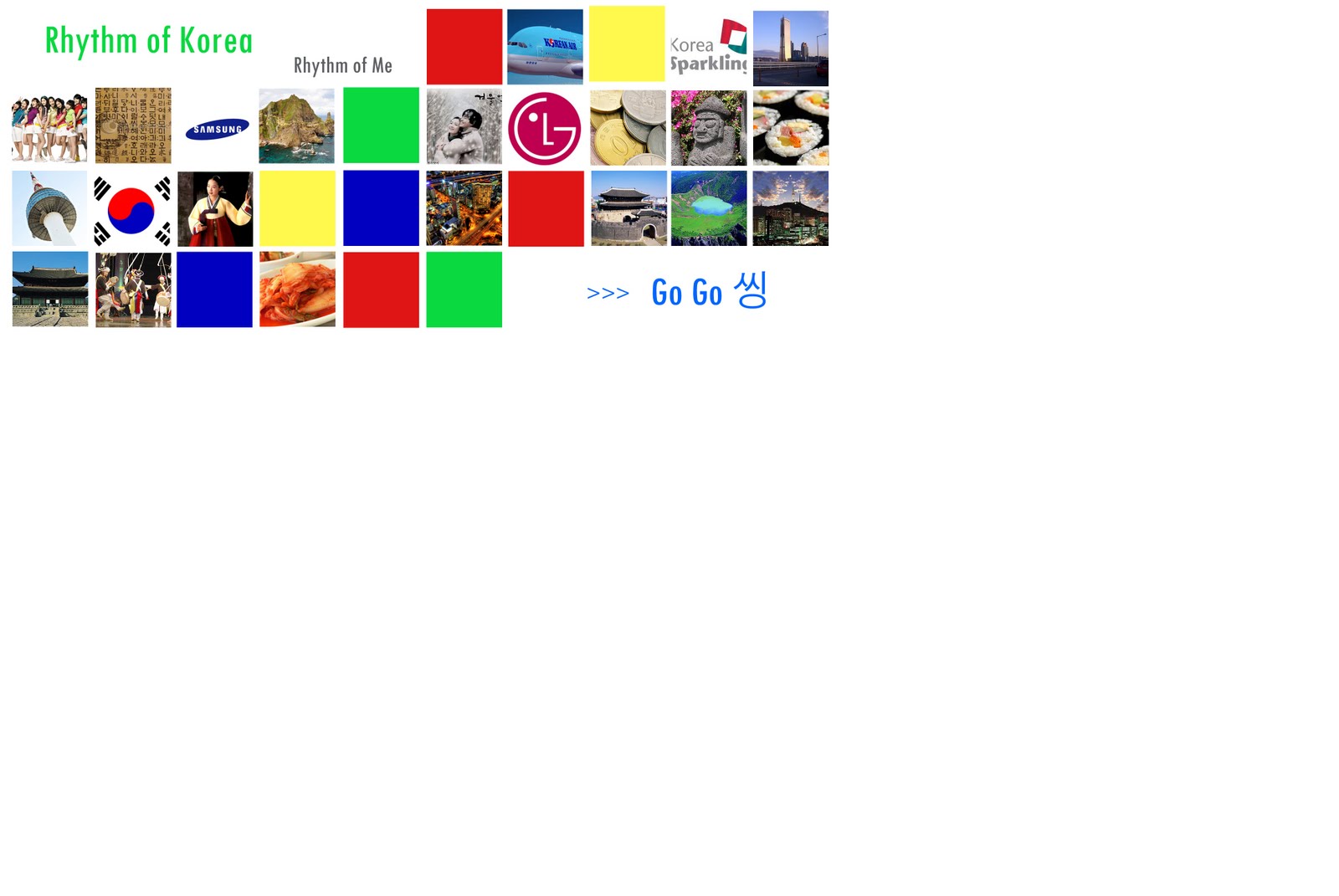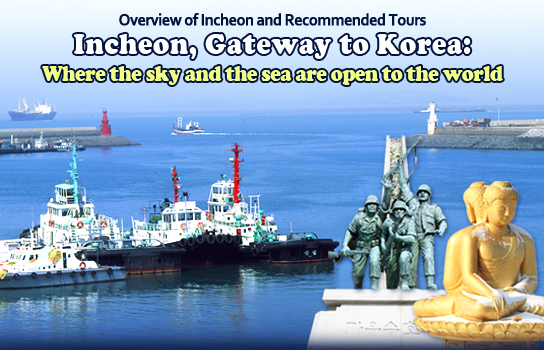Starting February 25th, downtown Seoul bus and subway fares will increase by 150 won.
Consequently, public transportation card holders will be charged 1050 won on downtown (blue and green) buses as well as on subway systems; 1,850 won on red bus; and 750 won for maeul (town) buses. Accordingly, prices of Subway Commuter’s Pass (for multiple journeys) and Single Journey Tickets will go up to 46,200 won from 39,600 won, and 1,150 won from 1,000 won, respectively.
The fare increase applies to adults only. Fares for children and senior citizens will remain the same.
Seoul Bus and Subway Fares to Rise
Labels:
Korea
Incheon, South Korea !

A historic city surrounded by islands
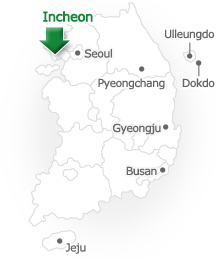 Incheon is the second largest port city in Korea. The Incheon Port is where Korea’s modernization began at the end of the 19th century, when it opened to foreign nations for the first time. Incheon is also home to the world’s top-ranked Incheon International Airport. As such, it is a gateway to the capital city of Seoul, and a major transportation gateway in Northeast Asia for destinations worldwide.
Incheon is the second largest port city in Korea. The Incheon Port is where Korea’s modernization began at the end of the 19th century, when it opened to foreign nations for the first time. Incheon is also home to the world’s top-ranked Incheon International Airport. As such, it is a gateway to the capital city of Seoul, and a major transportation gateway in Northeast Asia for destinations worldwide.Around the historic Incheon Port are China Town, Jayu Park, Wolmido Street of Culture, and the coastal wharf. There are many islands near Incheon, including Ganghwado Island, where there are many ancient historical sites such as Bronze Age dolmens; Yeongjongdo Island, the location of Incheon International Airport; and various other islands where famous Korean movies and dramas were filmed. Recently, Songdo International City is emerging as a new hotspot with skyscrapers filling this Free Economic Zone.
17th Asian Games
In 2014, Incheon will hold the 17th Asian Games. Member athletes of the 45 Olympic Councils of Asia (OCA) will participate. This will be the third Asian Games held in Korea, following the ones in Seoul (1986) and in Busan (2002). A number of stadiums will be built specially for this event, including the main stadium, whose shape will evoke sea waves and wind; the Dream Park stadium, which will be built as an environment-friendly park; and the Ganghwa Stadium, where taekwondo competitions will take place.- ☞ Period: September 19 - October 4, 2014 (for 16 days)
- ☞ Venue: Throughout Incheon
- ☞ Size: 45 member countries (13,000 athletes and officials, 7,000 media representatives)
- ☞ Events: 28 Olympic events, 8 non-Olympic events
- ☞ Website of the 2014 Incheon Asian Games: www.incheon2014ag.org

Labels:
Korea
Korea Grand Sale Free Shuttle Bus Service

During the 2012 Korea Grand Sale period, the Visit Korea Committee is operating a free shuttle bus service connecting major shopping and cultural destinations in Seoul three times a day, three days a week. The shuttle bus departs from Lotte Hotel (Sogong-dong), and goes through Myeongdong and Dongdaemun, before crossing over Hangang River to the Gangnam area to make stops at Sinsa-dong Garosu-gil road, Hyundai Department Store (Apgujeong Main Store), Cheongdam-dong Fashion Street, Bongeunsa Temple and COEX .
Labels:
Korea,
Special Event
Seoul Bike Show to Begin on February 24
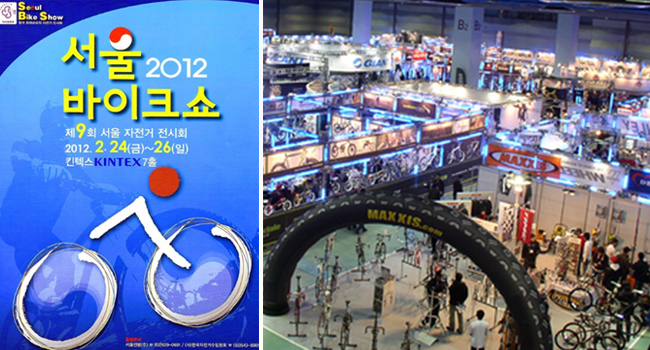
The 2012 Seoul Bike Show, an exhibition of the latest bicycles from around the world, is set to run from February 24 through 26 at the Korea International Exhibition Center (KINTEX) in Ilsan, Gyeonggi-do.
The Show will feature various types of bicycles like mountain bikes, electric bikes, toddler and children bikes, as well as bicycle gear and accessories including parts, clothing, etc. Moreover, visitors may try riding any of the bicycles representing 40 different brands after registering onsite.
The Show will feature various types of bicycles like mountain bikes, electric bikes, toddler and children bikes, as well as bicycle gear and accessories including parts, clothing, etc. Moreover, visitors may try riding any of the bicycles representing 40 different brands after registering onsite.
Labels:
Korea,
Special Event
លោកគីម ជុងអ៊ីល ទទួលបរមងារជា «មហាមេដឹកនាំសេនាប្រមុខ»
ខណៈដែលអតីតមេដឹកនាំកូរ៉េខាងជើង លោកគីម ជុងអ៊ីល ដែលទទួលមរណភាពទៅហើយមានបរមងារជាច្រើនដូចជាមហាមេដឹកនាំ មហាឧត្តមសេនីយ៍ មេបញ្ជាការជាន់ខ្ពស់របស់កងទ័ពប្រជាជន ឬមេដឹកនាំជាទីស្នេហា ក៏ប៉ុន្តែលោកគីម ជុងអ៊ីល នៅពុំទាន់ទទួលបានបរមងារជា «មហាមេដឹកនាំសេនាប្រមុខ» ដែលដាក់ជូនដល់ស្ថាបនិកកូរ៉េខាងជើង លោកគីម អ៊ីលស៊ុង តែម្នាក់គត់នៅឡើយ។
តាមរយៈការសម្រេចចិត្តរួមគ្នាមួយកាលពីថ្ងៃទី១៤ កុម្ភៈ របស់គណៈកម្មាធិការយោធាកណ្តាលនៃបក្សពលករកូរ៉េ គណៈកម្មាធិការការពារជាតិ និងគណៈកម្មាធិការអចិន្ត្រៃយ៍របស់ប្រេស៊ីឌីយ៉ូមនៃសភាប្រជាជនជាន់ខ្ពស់ បរមងារជា «មហាមេដឹកនាំសេនាប្រមុខ» ត្រូវបានផ្តល់ជូនលោកគីម ជុងអ៊ីល ដែលទទួលមរណភាពកាលពីខែធ្នូ កន្លងមកនេះ ។ ការផ្តល់បរមងារកំពូលនេះត្រូវបានរាយការណ៍កាលពីថ្ងៃទី១៥ កុម្ភៈ ដោយទីភ្នាក់ងារព័ត៌មានផ្លូវការកូរ៉េខាងជើង KCNA ។
KCNA រាយការណ៍ថា យើងសម្រេចផ្តល់ងារជាមហាមេដឹកនាំសេនាប្រមុខជូនសមមិត្តគីម ជុងអ៊ីល ដែលជាមហាមេដឹកនាំរបស់ប្រទេសយើង និងរបស់ប្រជាជនយើង ព្រោះតែលោកដឹកនាំឱ្យសម្រេចបានសមិទ្ធផលជាអមតៈទាំងឡាយសម្រាប់មាតុភូមិ និងបដិវត្តន៍របស់យើង៕
Labels:
Korean News
Unique Cafe over the Han River
Han River, which passes through Seoul is considered the most significant river among Koreans. You can enjoy the view from riverside or neighboring parks. However, there are also other places to recommend. If you want to see the river comfortably inside, regardless of weather, go to the Han River observation cafes. You might feel different from the other cafes as all of these observation cafes were built on the Han River Bridge. It will be a fun to find out the uniqueness of each cafe.
Han River has total of 10 observation cafes over seven Bridges. Among these, we chose six cafes thought to be more interesting and unique than the rest.
Let's find out the unusual and attractive cafes to enjoy the Han River at a glance. The cold wind always comes with the river, so don't forget to wear the warmest outfit.
Let's find out the unusual and attractive cafes to enjoy the Han River at a glance. The cold wind always comes with the river, so don't forget to wear the warmest outfit.
Cloud Cafe & Red Sky Cafe on Dongjak Bridge
Cloud Cafe and Red Sky Cafe are located each at upstream and downstream of Dongjak Bridge. Both cafes occupy three floors of the building from 3rd to 5th, and outdoor observation deck is on 6th floor. The operating hour is from 10 am to 2 am from March to October during the high-demand season, and from 10 am to midnight from November to February during the low-demand season.
For those of you who want to go to either one of cafes mentioned above, we recommend you to take a bus no.502 or a subway to Dongjak station (line no.4). It takes only three minutes’ walk from where you get off. To Cloud café, go to exit no.1, and to Red Sky café go to exit no.2. For drivers, there is a parking lot over a Dongjak Bridge, which charges 300 won per 10 minutes. If you park at other parking lot in Banpo Hangang Park, it costs 1000 won per 30 minutes, from Monday through Saturday, and 200 won per extra 10 minutes. For whole day, it costs 10,000 won. On Sunday and national holidays, it is free of charge.
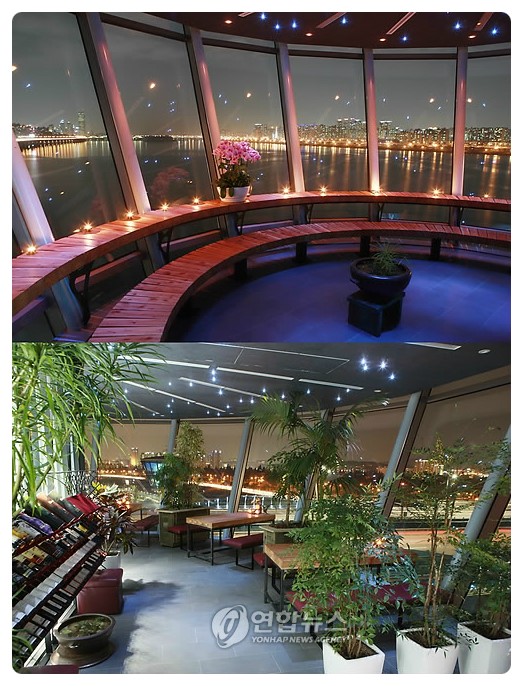
Cloud cafe and Red Sky cafe draw attention as a comfortable resting place with lights from the ceiling and scents of aroma. In addition, both of these places have been recognized as the most appropriate places to see the fountain show around Banpo Bridge, floating Island, and 63 Building, and also beautiful scenery of the Han River with sunset. Of course, they serve the wonderful cuisine.
If you ever used a water-taxi, you’ll get 20% discount in all menus of Red Sky cafe. Red Sky cafe is the only one in alliance with Han River water-taxi, so do not miss the chance!
Cafe Ariddaum(pretty) Yangwha & Cafe Ariddaum(pretty) Sunneu on Yangwha Bridge
Ariddaum Yangwha is located at upstream direction of Yangwha Bridge, and Ariddaum Sunneu is located at downstream direction separately. They stand facing each other with Yangwha Bridge between them. They have oriental and occidental themes. Ariddaum Yangwha adopted the oriental lattice interior, and Ariddaum Sunneu adopted the occidental tables and chairs, separately.
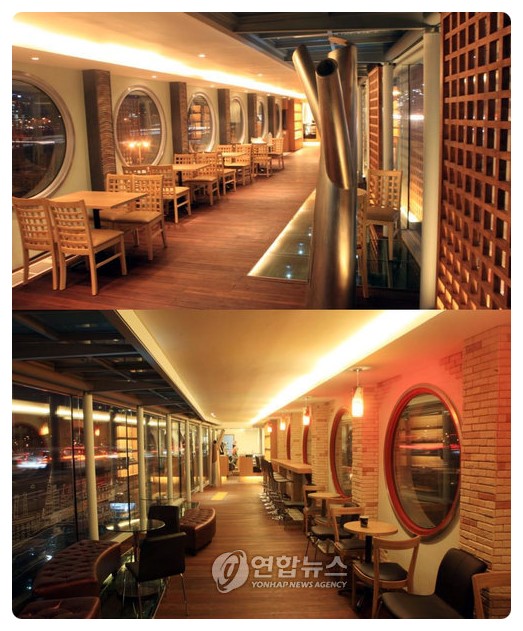
Unlike the other observation cafes, these two are located on a pedestrian passage. So, in order to reach from the waterside of the Han River, you have to use a rather unique elevator moving on a slant line. In terms of transportation, you can take a walk for about 15 minutes from the exit no.3 in Sunneudo subway station (line no.9), or use the bus either no.604, 5712, 6712 or 6716.
The operating hour is from 10 am to midnight in high-demand season (Mar.-Oct.), and from 10 am to 11 pm in low-demand season (Nov.-Feb.). Comparing to the previous Cloud and Red Sky Cafe, you can tell the difference from their operating hour. However, the same parking charge applies to all the Han Liver Cafes.
Both of these cafes sit in back-to-back position in direction, so each opposite side of the wall is toward a different view. The Cafe Ariddaum Yangwha avails the views of the Han River, Dangsan Railroad Bridge, Yeouido, etc., and the Cafe Ariddaum Seoneu avails the views of Seoneudo Park, Seongsan Bridge and World Cup Fountain.
In addition, they sell the coffee from East Timor through fair trade, and all menus are free of sugar, trans fat and chemical additives at all. They sell not only coffee but also they prepare alcohol liquors such as wine, makgeoli (rice wine), cocktail, etc. and also various drinks like herbal tea and juice, which satisfies the various tastes of people at the same time.
Marushimteo on Jamsil Bridge
On July 2011, 12 major facilities on Han River were renamed. Now, they all have new names after pure Korean words. Marushimteo is also one of the, which changed its name, which used to be ‘River View Spring’.
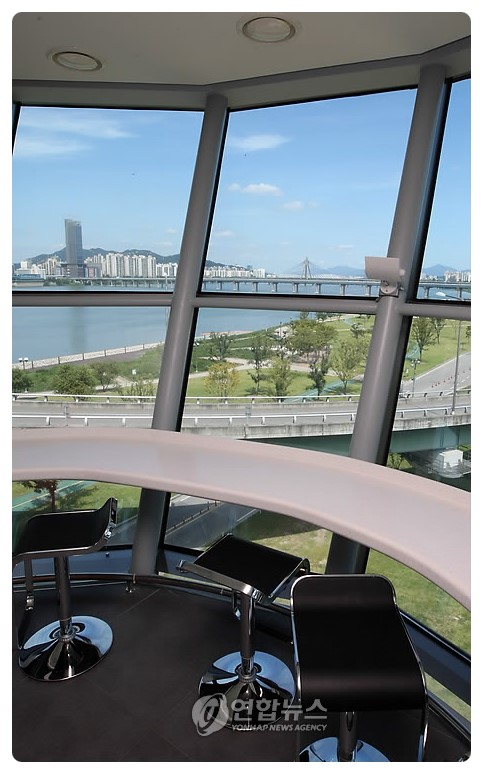
The operating hour is from 10 am to 11 pm. Walk toward Jamsil Bridge for about 10 minutes from exit no.7 in Jamsil subway station (line no.2), or by bus no.302, 303, 320, 8361, 2412, 2415, 3215, and 3216 to get to the café..
This place has been managed by the Seoul Foundation of Women & Family, and used as a place for women. Recently a female owned flower shop named ‘travelling painter’ moved into the place. You can buy some various flowers and flowerpots as well. Marushimteo also provides useful information on employment for women and promoting programs. It sells coffee, fruit juice, jujube tea, sweet pumpkin, makgeoli (rice wine) , etc. The price is lower than elsewhere. Computers are set up for visitors’ convenience. Besides, after 8 o'clock in the evening, the observation deck on 3rd floor turns off the whole internal lights to provide the vivid night view. It will be more romantic, if you come with your lover.
Well, there is one more place you shouldn’t miss. It is “Jamsil Under-water Reservoir Fish Road" which is a pathway to make fish easily move up to the uperstream of the river. A little fish also can pass through the artificial valley as it is only 10cms high. Every Saturday from April to October, from 11:00am to 12:30pm, an interesting and educational program named ’The Han River Fish Ecology Classroom opens for public. The target audiences are from kindergarten kids to junior high school students, including their family. Unfortunately, the program doesn’t open in winter.
Semal Cafe on Hannam Bridge
Hannam Semal cafe built on the southern end of Hannam Bridge is the first Han River Observation café among others. From here, you can see the Namsan Mountain, Banpo Bridge, moonlight rainbow, Jamwon Han River Park at a glance.
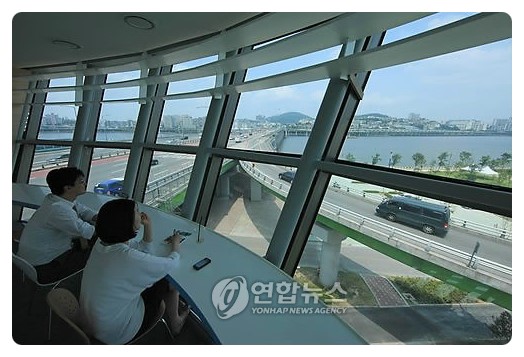
The operating hour is from 10 am to midnight in high-demand season, and from 10 am to 11 pm in low-demand season. You can come here by a transfer bus from exit no.4 in Sinsa subway station (line no.3) or exit no.6 or 7 in Nonhyeon subway station (line no.3). You can also come by bus either one of no.140, 142, 144, 241, 402, 408, 420, 421, 470, 471, or 472.
The most attractive thing of Semal Cafe is to be specialized for bike users. To prevent losing the bikes, it operates a unique place called "housing bike keeping place" and keep developing the set menu for bike users. In addition, in winter time, this place provides a free experience of herbal teas event for bike users. Moreover, this place has been the most distinguished by bike manias for its convenience.
The most popular menu of this place is a three color makgeoli cocktail. This unique menu is a magical cocktail which has three colors and three tastes. Along with this, you can taste various oriental teas such as Yeosu stone-mountain organic-farming citron tea, south sea organic-farming plum tea, etc. Such as Yangwha Bridge, the coffee brought from the East Timor in fare trade, is very popular.
The most popular menu of this place is a three color makgeoli cocktail. This unique menu is a magical cocktail which has three colors and three tastes. Along with this, you can taste various oriental teas such as Yeosu stone-mountain organic-farming citron tea, south sea organic-farming plum tea, etc. Such as Yangwha Bridge, the coffee brought from the East Timor in fare trade, is very popular.
Another consideration of Semal Cafe is mat-rental. It is available with 3000won in deposit. So you can enjoy the moment sitting on the picnic mat in the Han River Park from the spring to the autumn. As such, the Semal cafe sets a good example as a first-born brother, to think about a minor but essential and short-cut policy to make the Han River cafes be the friends of the citizens.
Just as the winter sea, compared to the summer, winter river gets relatively few visitors. Meanwhile, this cold season could be the best opportunity to monopolize the whole view of Hna River on your own. Why don’t you refresh yourself with the warmest tea over the river?
Labels:
Korea,
Korea Brand
Korean Ancient House
When you visit to foreign countries of old history, you will be amazed at old castles they have. At first, we are surprised at the beautiful castle which looks just cut-and pasted from a fairy tale, and amazed again by the fact that it has been coming down for over the hundreds of years. Tourists will continue to visit there, appreciating that how this beautiful castle still remains.
However, Korea also has many traditional buildings coming down through a few hundred. The best one is a Korean-style old house. Although it is not as high as other foreign castles, the whole structure and the view of the house is a piece of the artwork. It is a harmony of Korean style building placement and the composition of natural garden. It is said to be admirable even to the modern architects. From now on, let's go to see the grandeur and beautiful ancient houses representing Korea.
Sunkyeojang in Gangneung
An ancient house Sunkyeojang, located at Gangneung, was originally built by the 11th descendants of Prince Hyo-nyeong, the older brother of King Sejong, and has come down to the present going through the work of enlargement for 10 generations. This is a typical house for the gentry which comprises 99 units of area, and has higher value on its prototype which was preserved almost perfectly for a long period of 300 years. In 2000, the Korea Broadcasting Cooperation chose Sunkyojang as the best traditional house of Korea of 20 century. This place has been drawing people's attention as a film location for various dramas and movies including “Man of the Princess” which recently drew a large popularity. In addition, this place is often shown as a background in many programs on TV, and also became a visiting place for the ministers of tourism of Korea, China and Japan.

At this point, there is something which should be clarified. Koreans are familiar with the term, ‘a tile-roofed house with 99 units’. Then, why didn’t they build 100 units, adding one more unit? This was associated with the taboos of the past. Due to the fact that only the palace for a king's residence was allowed to be built more than 100 units of area, so the civilian house was restricted to 99 units utmost since no one could not live in a larger house than King's, as thought to be a general truth of the reason. This is proved by the story that Leem Sang-ok, a wealthy merchant of the latter period of Joseon Dynasty, got all sorts of sufferings from the accusation of building more than 100 units. Reaching to the end of the former Korea, with the regulation becoming disturbed, the cases of building over 100 units of houses gradually increased. However, on the whole, the limit of 99 units has been well kept. By the way the ‘unit’ means the land size not a room.
Sunkyeojang is located in front of the Maewalldang memorial place where you can see after the Gyeongpo intersection and turning left on the Unjung intersection. It opens for public from 9 am to 6 pm in summer, from 9 am and to 5 pm moved up by one hour in winter, and admission fee is 3000 won for an adult. If you come earlier,, you can enjoy the place more comfortably with introduction by commentator. Smoking is prohibited all over the area as the whole buildings were made of wood.
A lodging experience is a representative and practical use of this place. With a large site and many buildings, 9 choices for lodging, from a tile-roofed house for the group to a thatched house for the elegant residence, are prepared without missing anything. Although cooking is not allowed for safety of the building, lower prices and cozy facility is attractive enough.

Besides, the cultural experience is also very plentiful. Traditional food, folk play, courtesy, and a public performance experience are made ready basically, and a finishing school and calligraphy school are opened on not-permanent standing. And in 2009, a library, holding above 2000 copies, will be made in Yulwhadang, a gusting room in Sunkyeojang, which will introduce visitors to the joy of reading. Moreover, surroundings are full of famous attractions such as Gyungpodae, Jungdongjin, Ojukheon, Odae Mountain., Seorak Mountain, etc. The number of tourists visiting Gangneung continuously increases.
130 Years of History, Songso Ancient House
Before looking into the history of Songso ancient house, we need to look over the history of the Shims of Cheongsong area.
The Shims, started by the originator Shim Hong-bu during the reign of King Choong-yul of Goryeo dynasty, settled in Cheongsong area which became a place of their origin. Their power reached the highest during the reign of King Gong-min and a King Yu. The two prominent figures from the Shims then were brothers, Shim Duk-bu and Shim Uen-bu. The older brother, Shim Duk- bu had served the ministry as a meritorious retainer for the foundation of a country, and the daughter of his fifth son Shim On became an Empress Sohyeon, a wife of the King Sejong in Joseon Dynasty.
The Shims, started by the originator Shim Hong-bu during the reign of King Choong-yul of Goryeo dynasty, settled in Cheongsong area which became a place of their origin. Their power reached the highest during the reign of King Gong-min and a King Yu. The two prominent figures from the Shims then were brothers, Shim Duk-bu and Shim Uen-bu. The older brother, Shim Duk- bu had served the ministry as a meritorious retainer for the foundation of a country, and the daughter of his fifth son Shim On became an Empress Sohyeon, a wife of the King Sejong in Joseon Dynasty.
On the other hand, the younger brother Shim Uen-bu, unlike his older brother, opposed to the dynasty revolution and went into the Dumundong confining himself at home, and the rest of his descendents also stepped down from the government and came back to their hometown, Cheongsong, following the will of an ancestor. They worked together in cooperation and brought the wealth enough to be one of two richest families with the Choi's of Gyeongju, the southeast region of Korea. The myth of a person who owns fields yielding as much as 10,000 seok of rice over 9 generations, were born from them. Among them, Songso Shim Ho-teak, a 7th generation descendant, built the Songso ancient house in 1880, naming it under his pseudonym.
Songso ancient house has a typical upper-class house configuration of 7 sections and 99 units of area, and with being recognized of the almost perfectly preserved value, was designated as an Nationally Important Folk Material No.250. Having been neglected for 20 years since the descendants left, it was reborn as a hands-on experiencing place of Korean-style house after repaired in July 2010. The change proved to be successful by receiving the best award called, the Star of Korea Tourism, in lodging.
Songso ancient house has a typical upper-class house configuration of 7 sections and 99 units of area, and with being recognized of the almost perfectly preserved value, was designated as an Nationally Important Folk Material No.250. Having been neglected for 20 years since the descendants left, it was reborn as a hands-on experiencing place of Korean-style house after repaired in July 2010. The change proved to be successful by receiving the best award called, the Star of Korea Tourism, in lodging.

The look of a tall front gate made of 7 units, standing in the entrance, overwhelms the visitors. Entering the gate, there appears a garden where maple trees and pine trees were planted. Sarangche, men’s space appears on the right side of it. Looking at the view from high above, you will learn that entire place is divided each into spaces for living, working, and welcoming guests. Besides, each building has its own independent yard, so the total is 9.
In Songso ancient house, you can find many interesting details everywhere.
First of all, entering into the tall gate, ‘ㄱ’ shaped-wall, called heotdam, separating wall. It was used to prevent children and women of inside from encountering the male guests visiting sarangche. In addition, when you take a closer look at the Kkotdam, a flower wall, you can find the hole in line with eye-level, which is said to be a hole used for the children and women inside of the house to see the outside. Who knows it could be used vice-versa?
First of all, entering into the tall gate, ‘ㄱ’ shaped-wall, called heotdam, separating wall. It was used to prevent children and women of inside from encountering the male guests visiting sarangche. In addition, when you take a closer look at the Kkotdam, a flower wall, you can find the hole in line with eye-level, which is said to be a hole used for the children and women inside of the house to see the outside. Who knows it could be used vice-versa?

Also, when you see the roof, a little bit scary picture is painted at the edge. This is said to be the purpose to expel the evil spirit. If you see the upper part, you can see the two holes which were made for the birds to build a nest easily, and recognize the warm heart of ancestors.
Lastly, we will take a look at the byeolche, women’s space, sticking out of the side of Songso ancient house. This place was a space for the unmarried women in Songso ancient house, and the girls over seven years old should move to byeolche and live locked in the place until she gets married. This place was indeed a space for raising the women of a boudoir who hadn’t experienced the outside. However, at present, this place turns to be the most expensive accommodation because of its uniqueness and a harmony with surrounding landscape. How about staying one night here and feeling the mood of the lady who dreamt of a dear future husband?
The Scar Left by Japanese Imperialism, Imcheonggak
Imcheonggak is a unusual Korean-style house in a sense that the present appearance is quite different from the one in the past. In the early days, Imcheonggak stood with a proud of its dignified appearance of 99 units of area. However, since it was found that 9 pro-independence fighters were born in this house, Japanese demolished almost half of the house by putting down the central railroad in the front of the house. In addition, as the descendants refused to add themselves to Japanese family register, Japanese confiscate their house and sold to others. Since then, the descendants had to wander around orphanages.
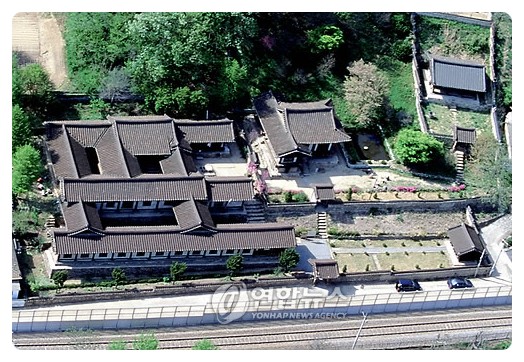
Imcheonggak is one of the oldest ancient houses, and used to be outstanding in its scale until 19 century. Built in 1519, its scale has become huge by continuous expansion. It has the board written by Lee Hyun-bo and Lee Hang-bok, the prominent civil ministers in the mid Joseon Dynasty, so we can imagine their high social reputation was.
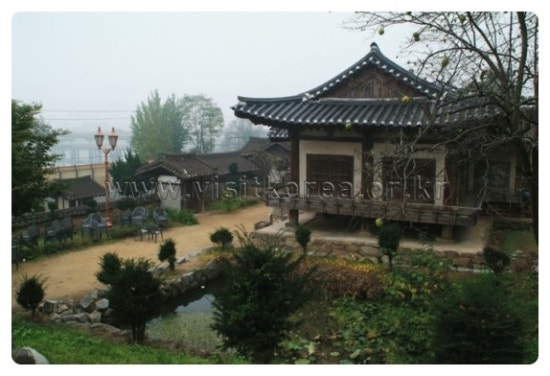
<Imcheonggak returning to original appearance little by little> (Photo: Korea Tourism Organization)
The full figure of Imcheonggak has a flat formation which looks like a Chinese letter, ‘用 (lyong)’’. It tells that it separated each place by gender and social status. Also, Gunjajeong, located at the center of Imcheonggak and later designated as National Treasure, is for welcoming guests, which looks like a letter, ‘丁(jeong)’. This is the best spot to take a view of Nakdong River flowing over the front and the Yeunnam Mountain surrounding the building.
Ancient houses were not built with 99 units of area from the beginning. They got bigger and bigger for a long period of time. It was for practical use rather than ostentation. When the house was crowded with peoples, it needed a lot of rooms for many literary guests and travelers from all over the country as well as for the family, relatives, and the servants to take their own space. Distinguished family always emphasized to welcome their guests. With this, we can see the fact that what they concerned about is a human being rather than property.
The biggest lesson, which the ancient house is giving to us, seems that we should live together, harmonized with others.
Labels:
Korea,
Korea Brand
ASEAN-KOREA Blogger
ASEAN-Korea Centre s are looking for writers who are the citizens of the 10 ASEAN countries including Brunei, Cambodia, Malaysia, Indonesia, Laos, Myanmar, Singapore, Thailand and Vietname for their english blogs. Please read further if interested.
http://www.aseankorea.org/
http://www.aseankorea.org/
Labels:
Korea,
Special Event
Application for 2012 Government Scholarship Program
| Application for 2012 Government Scholarship Program The Ministry of Education, Science and Technology is recruiting '2012 Government Scholarship Students'. For more details, please refer to the following information.1. Qualification : Applicants must meet all the following conditions: a. Inha undergraduate students who are 2nd or 3rd or 4th year. b. GPA for the last and whole semester must be over 80 out of 100. c. Applicants must pass a minium fourth level in the Test of Proficiency in Korean (TOPIK). ※ Students who have already received scholarships from the Government of Korea or other institutions are NOT allowed to apply. (ex. Students who have received over 300,000won(per month) scholarships from Korean and foreign governments or Il-Woo Foundation or Inha University are NOT allowed to apply) 2. Quota : Total 200 international students from all universities in Korea 3. Scholarship a. Amount : Annually KRW 6 million per student (KRW 0.5 million X 12 months) b. Winners of the Scholarhip will receive the money over an year. 4. Application a. where to apply : International Center, Inha University b. Application Deadline : 17:00 Feb. 27 (Mon) 2012 c. Application Documents : 1) Application Document : 1 original document and 3 copies 2) Copy of Passport : 3) Certificate of Enrollment 4) Official Tran : 1 Korean version and 1 English ※ Tran must be officially issued by Inha University. GPA should be converted into the percentage in the tran. Transfer students must also submit trans of all universities attended. 5) a Proof of Proficiency of Korean (TOPIK) / It should be issue after Mar. 1 2010 6) a letter of self-introduction and study plan 7) a letter of recommendation ※ A letter of recommendation must include personal information of both recommender and recommendee and a signature of the recommender. It should be sealed by the recommender. 8) Other Documents (ex. proof of English proficiency, proof of other achievements or awards) 5. Important Things a. Applicant's English name must be identical to the one shown in the passport b. All the application documents must be A4 size c. tran must be officially issued by Inha University. d. application documents must be properly sorted out and submitted. e. If the application documents are false, the applicant is NOT eligible. f. If an student wins the scholarship but later drop out of school, the scholarship is stripped off. g. Application documents will NOT be returned |
Labels:
Inha,
Korea,
Special Event
Subscribe to:
Posts (Atom)
